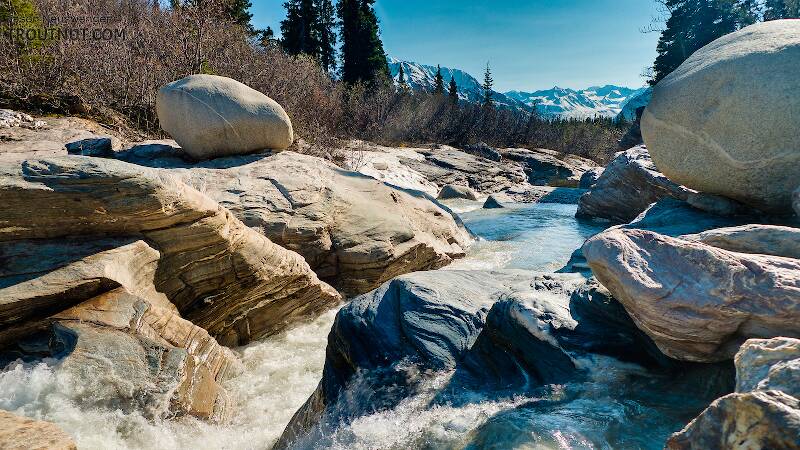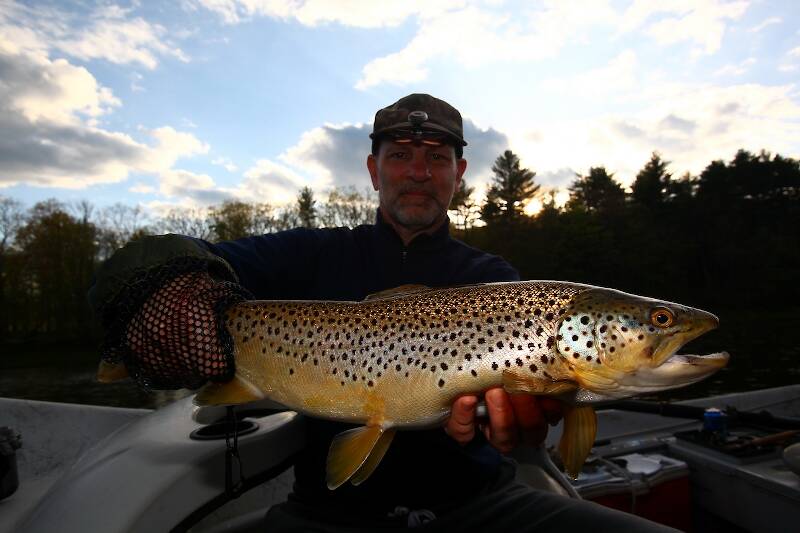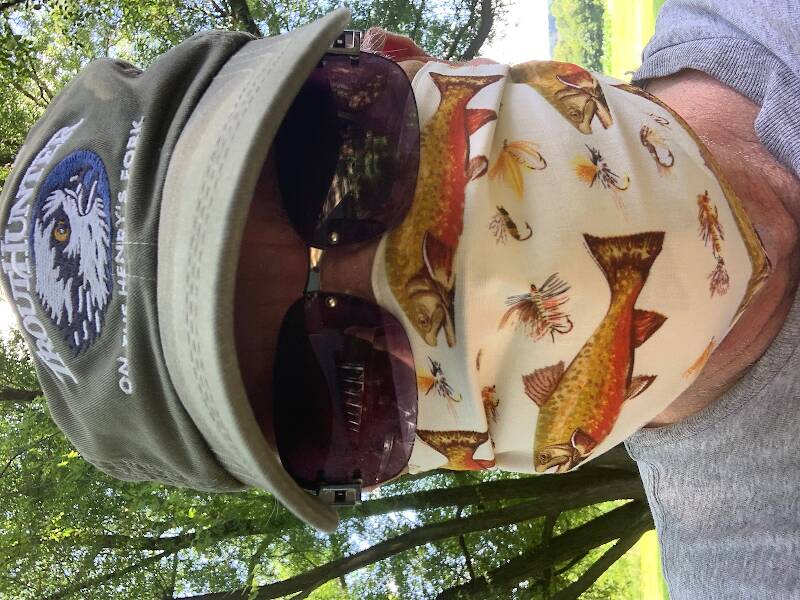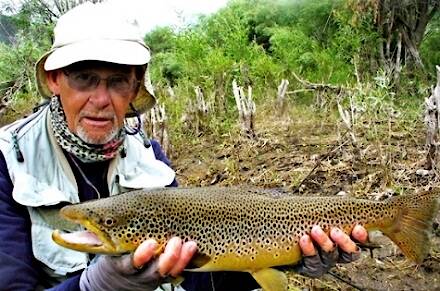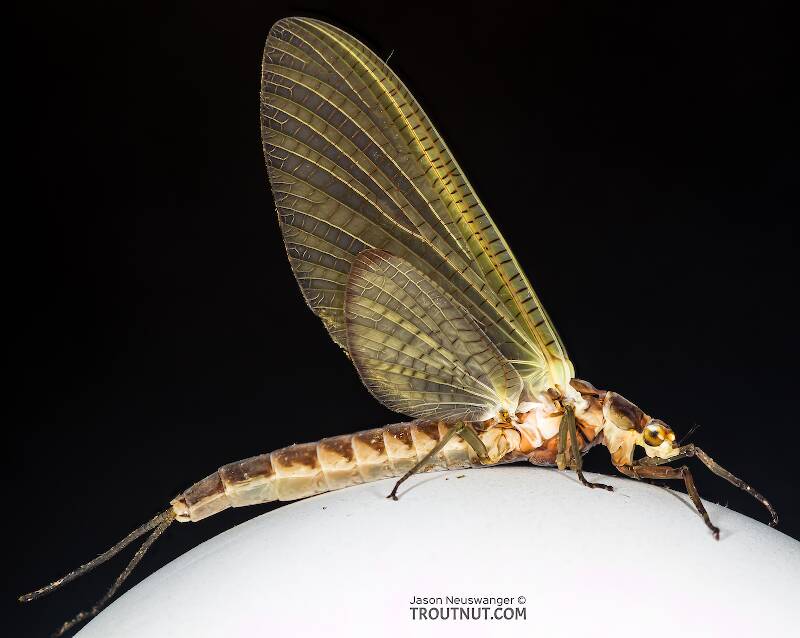
Hex Mayflies
Hexagenia limbata
The famous nocturnal Hex hatch of the Midwest (and a few other lucky locations) stirs to the surface mythically large brown trout that only touch streamers for the rest of the year.
Featured on the forum
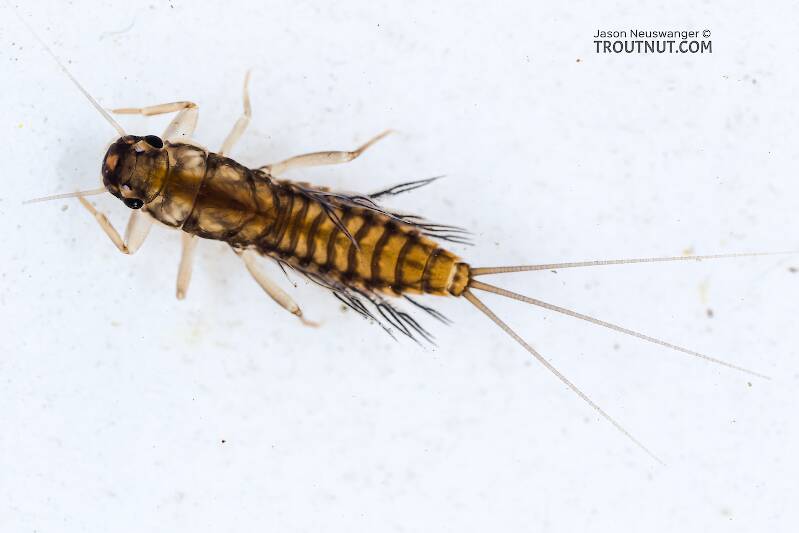
Some characteristics from the microscope images for the tentative species id: The postero-lateral projections are found only on segment 9, not segment 8. Based on the key in Jacobus et al. (2014), it appears to key to Neoleptophlebia adoptiva or Neoleptophlebia heteronea, same as this specimen with pretty different abdominal markings. However, distinguishing between those calls for comparing the lengths of the second and third segment of the labial palp, and this one (like the other one) only seems to have two segments. So I'm stuck on them both. It's likely that the fact that they're immature nymphs stymies identification in some important way.

Troutnut is a project started in 2003 by salmonid ecologist Jason "Troutnut" Neuswanger to help anglers and
fly tyers unabashedly embrace the entomological side of the sport. Learn more about Troutnut or
support the project for an enhanced experience here.
LittleJ on Feb 22, 2007February 22nd, 2007, 2:08 pm EST
I have always used traditional adams style dry flys but have tied up some compara duns this year. I'm just curious if any of you have ever fished both of them during the same hatch, and if so what were your experiences and or preferences? Also do you die deer/elk hair to match or just use natural colors?
Jeff
Jeff
GONZO on Feb 22, 2007February 22nd, 2007, 2:31 pm EST
Jeff,
I'm assuming that by "adams" style you are referring to what some would call Catskill style dries? (Meaning hackled and winged in a conventional fashion.) If so, both styles can be effective. Sometimes the fish will prefer one or the other, and sometimes both will work equally well.
The Compara-dun style floats with its body in the film, while the traditional dry stands tall on its hackles. The traditional style is probably better for representing active duns that are ready to take flight and for active (twitching) presentations. The Compara-dun better represents freshly hatched or even crippled duns, and when the body sinks below the surface it becomes like an emerger. Regardless, having two different styles to represent the hatch is always a useful option, especially over pressured fish.
As for the wings, I like a synthetic-winged version of the Compara-dun. (That largely solves the color issue.) For natural hair wings, both dyed and natural variations can be used. Because many mayfly wings are shades of grey, the natural variations are often all that you need.
Gonzo
I'm assuming that by "adams" style you are referring to what some would call Catskill style dries? (Meaning hackled and winged in a conventional fashion.) If so, both styles can be effective. Sometimes the fish will prefer one or the other, and sometimes both will work equally well.
The Compara-dun style floats with its body in the film, while the traditional dry stands tall on its hackles. The traditional style is probably better for representing active duns that are ready to take flight and for active (twitching) presentations. The Compara-dun better represents freshly hatched or even crippled duns, and when the body sinks below the surface it becomes like an emerger. Regardless, having two different styles to represent the hatch is always a useful option, especially over pressured fish.
As for the wings, I like a synthetic-winged version of the Compara-dun. (That largely solves the color issue.) For natural hair wings, both dyed and natural variations can be used. Because many mayfly wings are shades of grey, the natural variations are often all that you need.
Gonzo
JAD on Feb 22, 2007February 22nd, 2007, 3:11 pm EST
Hello Jeff
I'm just curious if any of you have ever fished both of them during the same hatch, and if so what were your experiences and or preferences? Yes. I have fished both doing the same hatch I prefer the compara dun, I think if you checked most fisherman they will have standard Adam patterns not so with Compara Duns. At the end of hatch you have the cripple factor which compar dun more closely matches .IMHO. Last year I used standard Elk Hair but this year I tied some up with Zelon thanks to Lloyd so we will Seeeee.
Regards
JaD
They fasten red (crimson red) wool around a hook, and fix onto the wool two feathers which grow under a cock’s wattles, and which in colour are like wax.
Radcliffe's Fishing from the Earliest Times,
GONZO on Feb 22, 2007February 22nd, 2007, 3:35 pm EST
Hi John! How are you? Glad to have you back online. -Lloyd
Martinlf on Feb 22, 2007February 22nd, 2007, 3:41 pm EST
Hey John, good to hear from you. Bill Anderson also ties with Zelon. He has a cripple pattern somewhat like Gonzo's Zelon Comparaduns (which I too am trying out this year), but he ties it on a scud/emerger hook, splits the wings, and starts with a dark orange thread tag that imitates a shuck.
"He spread them a yard and a half. 'And every one that got away is this big.'"
--Fred Chappell
--Fred Chappell
LittleJ on Feb 23, 2007February 23rd, 2007, 1:10 am EST
I like the synthetic fibers idea, I looked back at gonzos book and that seems like the way to go. Thanks for the input.
Jeff
Jeff
Wiflyfisher on Apr 15, 2007April 15th, 2007, 2:30 am EDT
I have used Compara-duns for years with great success East to West. It is my favorite mayfly dun pattern. The key to a good wing is to use "very fine coastal deerhair" for the smaller patterns. Floats well and is very durable.
For emergers and cripples I do use synthetic materials as an alternative.
I also have friends who tie a more conventional dryfly and then clip short the hackles underneath the hook. They too do well during a hatch.
For emergers and cripples I do use synthetic materials as an alternative.
I also have friends who tie a more conventional dryfly and then clip short the hackles underneath the hook. They too do well during a hatch.
John S.
https://WiFlyFisher.com
https://WiFlyFisher.com
Spud
Posts: 7
Posts: 7
Spud on May 13, 2007May 13th, 2007, 8:00 am EDT
Hello all, first time posting.
I just wanted to add that I have had significantly better success using Catskill style dries after the hatch has winded down and the majority of the duns are in the air. During the thick of the hatch, I think Compara-duns edge out Catskill style dries because they sit in the surface film and are less of a flight-risk for hungry trout.
I just wanted to add that I have had significantly better success using Catskill style dries after the hatch has winded down and the majority of the duns are in the air. During the thick of the hatch, I think Compara-duns edge out Catskill style dries because they sit in the surface film and are less of a flight-risk for hungry trout.
Nightfisher
Posts: 7
Posts: 7
Nightfisher on Jun 14, 2007June 14th, 2007, 9:48 am EDT
The more I fish the more I think that flies in the film out perform the high floaters. I am a big fan of emergers during a hatch. Spinners, of course, ride in the film. When I use a high floating dun I will almost always use an emerger as a dropper.
And I love compara duns. They are pretty easy to tie also.
And I love compara duns. They are pretty easy to tie also.
Troutnut on Jun 14, 2007June 14th, 2007, 1:23 pm EDT
I prefer comparaduns lately (Gonzo's synthetic kind, because of the color). Apart from the advantages already mentioned, one thing I really like about comparaduns is that they pretty much always land upright with a strong wing silhouette. If you're anything like me, some of your casts are far from perfect and your Catskill dries land on their side, upside down, and in other odd positions much more often than you would like them to. Some of that can be corrected by tying them with just the right balance, but even then the comparadun is just more forgiving of poor casts.
Jason Neuswanger, Ph.D.
Troutnut and salmonid ecologist
Troutnut and salmonid ecologist
LittleJ on Jun 14, 2007June 14th, 2007, 3:41 pm EDT
I've also been having more luck lately with compara duns and klinkhamers(i'm not sure of spelling on that). But I'm curious if it is that they float flush or that the trout see less of them than they do the more popular catskill ties. Early in the season I was fishing both with equal results, the past few weeks they really haven't even sniffed any catskills. I realize this could be any number of things mentioned above,but I'm curious if any of you notice the same.
Jeff
Jeff
Wbranch on Jul 24, 2007July 24th, 2007, 8:10 am EDT
I prefer compara-duns or thorax duns with the hackle clipped flat on the bottom for 95% of my dry fly fishing. There are times when I'll still use a big fully hackled variant or when I go to a hook size larger than a #12, on swifter water, hackled flies float longer and the trout don't seem to care as they must feed opportunistically in swift water.
Regarding the color of the wing I agree with another poster in the "fine coastal deer hair". Sometimes it is not that easy to find though. I like to use colors that match that of the natural but if you look at most compara-duns in fly shops the wing is usually just the natural mixed brown speckled deer hair. Darker wings are much easier to see on falling light conditions too.
Regarding the color of the wing I agree with another poster in the "fine coastal deer hair". Sometimes it is not that easy to find though. I like to use colors that match that of the natural but if you look at most compara-duns in fly shops the wing is usually just the natural mixed brown speckled deer hair. Darker wings are much easier to see on falling light conditions too.
Catskill fly fisher for fifty-five years.
Wiconisco37 on Nov 9, 2008November 9th, 2008, 1:24 pm EST
As I always say, if you get the size and shape of the fly down, (matching color doesn't match too much, but dark, medium or light should be close) and if you get a perfect drift over an unspooked fish (perfect presentation) and get your fly on the right of the 5 levels (1. surface, 2. just below surface, 3. mid depth, 4. near bottom, 5. on the bottom) you can have sucess with any fly.
I'm only 14, but I've fly-fished constantly since I was 11.
I'm only 14, but I've fly-fished constantly since I was 11.
Martinlf on Nov 9, 2008November 9th, 2008, 3:20 pm EST
Hi Wiconisco37,
Your comments sound exactly on target. You've learned a lot in a few years, and it sounds like you are going to be one awesome fly fisherman soon, if you're not there already.
Your comments sound exactly on target. You've learned a lot in a few years, and it sounds like you are going to be one awesome fly fisherman soon, if you're not there already.
"He spread them a yard and a half. 'And every one that got away is this big.'"
--Fred Chappell
--Fred Chappell
Leakywaders on Nov 17, 2008November 17th, 2008, 11:27 am EST
Comparaduns are one of those things that just seem too good to be true. Easier to tie, Cheaper, and they work better. Why didn't we figure that out 100 years ago?
Pete
Pete
Drag free??? If the fly didn't drag, I wouldn't know where it was!!
Quick Reply
Related Discussions
Topic
Replies
Last Reply

